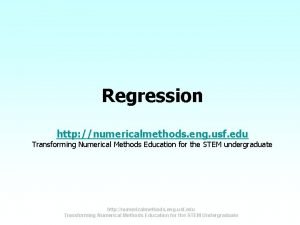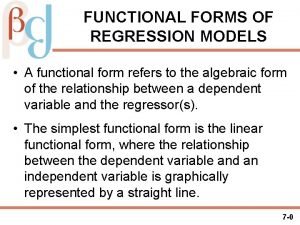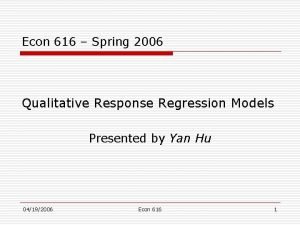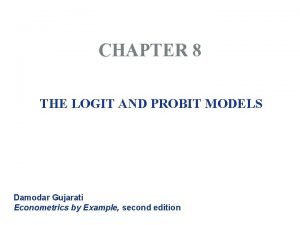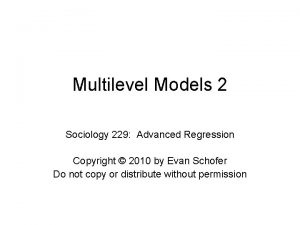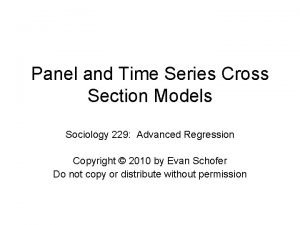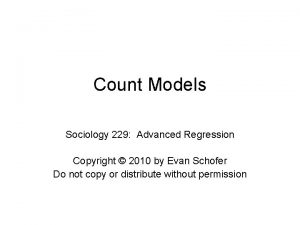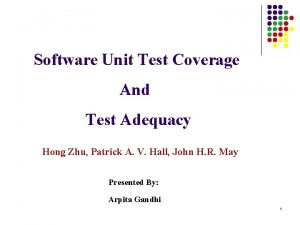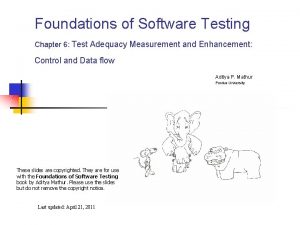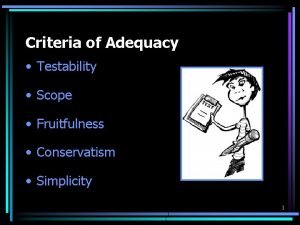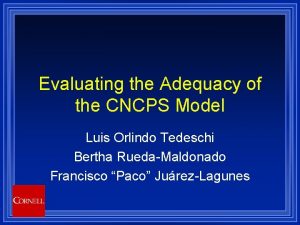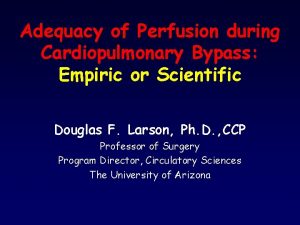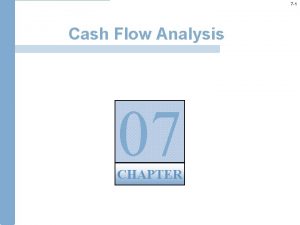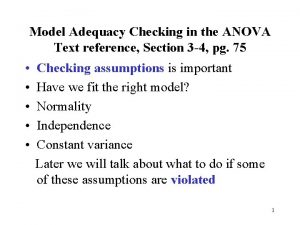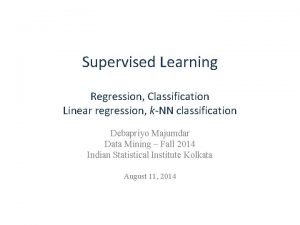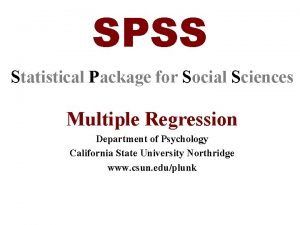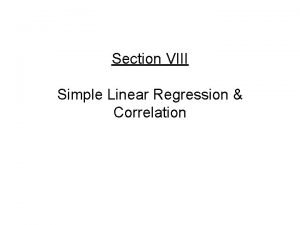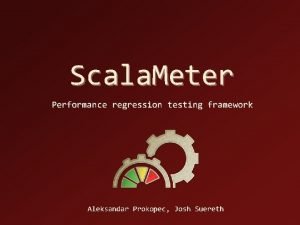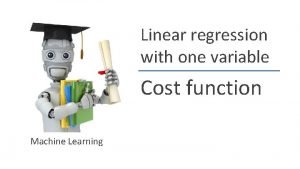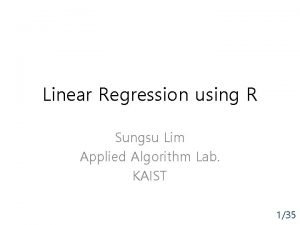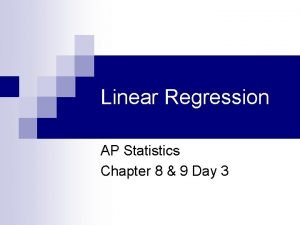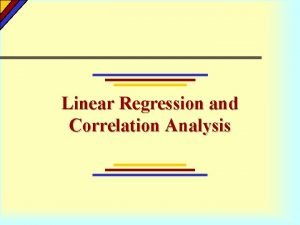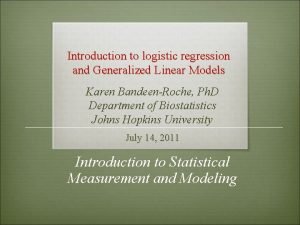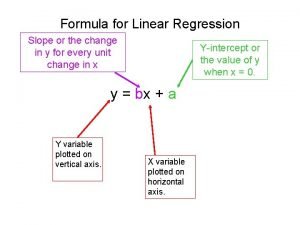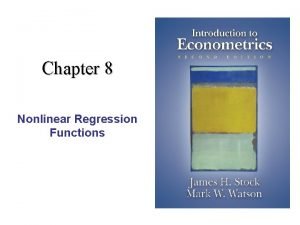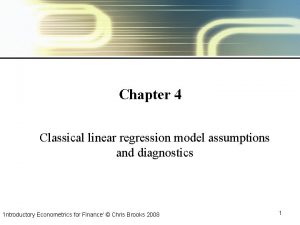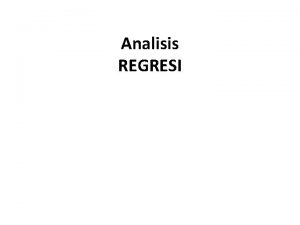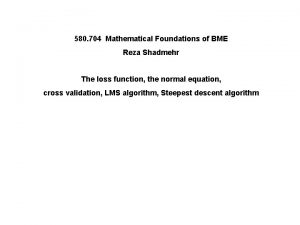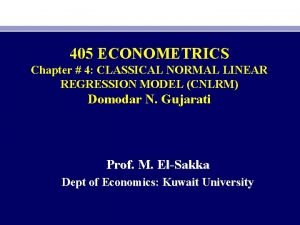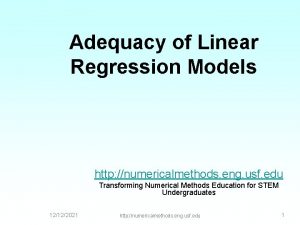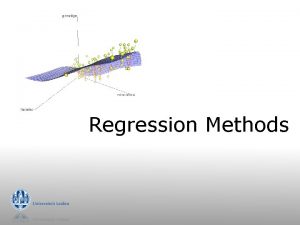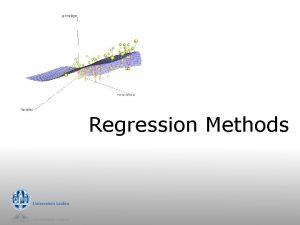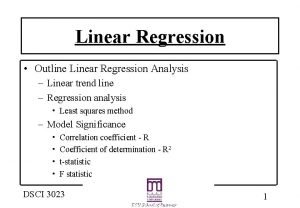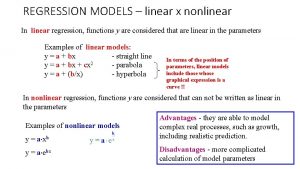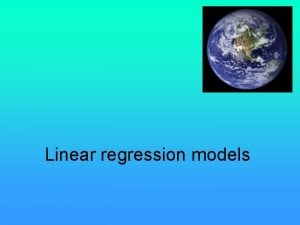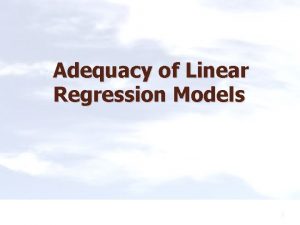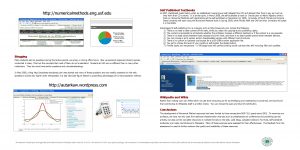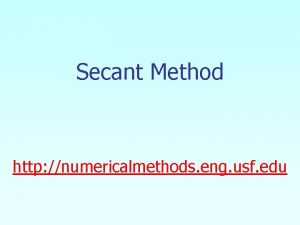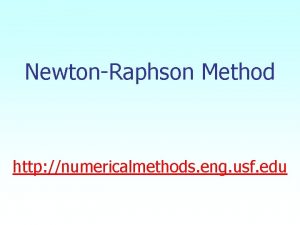Adequacy of Linear Regression Models http numericalmethods eng














































- Slides: 46

Adequacy of Linear Regression Models http: //numericalmethods. eng. usf. edu Transforming Numerical Methods Education for STEM Undergraduates 6/6/2021 http: //numericalmethods. eng. usf. edu 1

Data

Therm exp coeff vs temperature T α T 80 6. 47 -140 4. 91 60 6. 36 -160 4. 72 40 6. 24 -180 4. 52 20 6. 12 -200 4. 30 0 6. 00 -220 4. 08 -20 5. 86 -240 3. 83 -40 5. 2 -260 3. 58 -60 5. 58 -280 3. 33 -80 5. 43 -300 3. 07 -100 5. 28 -320 2. 76 -120 5. 09 -340 2. 45 α T is in o. F α is in μin/in/ o. F

Is this adequate? Straight Line Model

Quality of Fitted Data • Does the model describe the data adequately? • How well does the model predict the response variable predictably?

Linear Regression Models • Limit our discussion to adequacy of straight-line regression models

Four checks 1. Does the model look like it explains the data? 2. Do 95%of the residuals fall with ± 2 standard error of estimate? 3. Is the coefficient of determination acceptable? 4. Does the model meet the assumption of random errors?

Check 1: Does the model look like it explains the data?

Data and Model -340 -260 -180 -100 -20 60 2. 45 3. 58 4. 52 5. 28 5. 86 6. 36

Check 2. Do 95%of the residuals fall with ± 2 standard error of estimate?

Standard error of estimate

Standard Error of Estimate -340 -260 -180 -100 -20 60 2. 45 3. 58 4. 52 5. 28 5. 86 6. 36 2. 7357 3. 5114 4. 2871 5. 0629 5. 8386 6. 6143 -0. 28571 0. 068571 0. 23286 0. 21714 0. 021429 -0. 25429

Standard Error of Estimate

Standard Error of Estimate

Scaled Residuals • • 95% of the scaled residuals need to be in [-2, 2]

Scaled Residuals • Ti αi Residual -340 -260 -180 -100 -20 60 2. 45 3. 58 4. 52 5. 28 5. 86 6. 36 -0. 28571 0. 068571 0. 23286 0. 21714 0. 021429 -0. 25429 Scaled Residual -1. 1364 0. 27275 0. 92622 0. 86369 0. 085235 -1. 0115

3. Is the coefficient of determination acceptable?

Coefficient of determination

Sum of square of residuals between data and mean • y x

Sum of square of residuals between observed and predicted • y x

Calculation of St -340 -260 -180 -100 -20 60 2. 45 3. 58 4. 52 5. 28 5. 86 6. 36 -2. 2250 -1. 0950 0. 15500 0. 60500 1. 1850 1. 6850

Calculation of Sr -340 -260 -180 -100 -20 60 2. 45 3. 58 4. 52 5. 28 5. 86 6. 36 2. 7357 3. 5114 4. 2871 5. 0629 5. 8386 6. 6143 -0. 28571 0. 068571 0. 23286 0. 21714 0. 021429 -0. 25429

Coefficient of determination

Limits of Coefficient of Determination • •

Correlation coefficient How do you know if r is positive or negative ?

What does a particular value of |r| mean? 0. 8 to 1. 0 - Very strong relationship 0. 6 to 0. 8 - Strong relationship 0. 4 to 0. 6 - Moderate relationship 0. 2 to 0. 4 - Weak relationship 0. 0 to 0. 2 - Weak or no relationship

Final Exam Grades 100 Final Exam Grade 90 80 70 60 50 40 0 10 20 30 Student No 40 50 60

Final Exam Grade vs Pre-Req GPA R 2 = 0. 2227 100 FInal Exam Scores 90 80 70 60 50 40 1 2 3 Pre-Requisite GPA 4 5

Redoing Check 1, 2 and 3 with 22 data points

Check 1: Plot Model and Data T α T 80 6. 47 -140 4. 91 60 6. 36 -160 4. 72 40 6. 24 -180 4. 52 20 6. 12 -200 4. 30 0 6. 00 -220 4. 08 -20 5. 86 -240 3. 83 -40 5. 2 -260 3. 58 -60 5. 58 -280 3. 33 -80 5. 43 -300 3. 07 -100 5. 28 -320 2. 76 -120 5. 09 -340 2. 45 α

Check 2: Using Standard Error of Estimate

Check 3: Using Coefficient of Determination

Check 4. Does the model meet assumption of random errors?

Model meets assumption of random errors • • Residuals are negative as well as positive Variation of residuals as a function of the independent variable is random Residuals follow a normal distribution There is no autocorrelation between the data points.

Are residuals negative and positive?

Is variation of residuals as a function of independent variable random?

Do the residuals follow normal distribution?

END

What polynomial model to choose if one needs to be chosen?

Which model to choose?

Optimum Polynomial: Wrong Criterion Both graphs are same Left one starts at m=1 Right one starts at m=2

Optimum Polynomial: Correct Criterion Both graphs are same Left one starts at m=1 Right one starts at m=2

END

Effect of an Outlier

Effect of Outlier

Effect of Outlier
 Numericalmethods.eng.usf.edu
Numericalmethods.eng.usf.edu Numericalmethods.eng.usf.edu
Numericalmethods.eng.usf.edu Pde
Pde Linear regression vs multiple regression
Linear regression vs multiple regression Survival analysis vs logistic regression
Survival analysis vs logistic regression Logistic regression vs linear regression
Logistic regression vs linear regression Multiple regression
Multiple regression Funksiyaning eng kichik qiymati
Funksiyaning eng kichik qiymati Logarithmic reciprocal model
Logarithmic reciprocal model Qualitative response regression models
Qualitative response regression models Qualitative response regression models ppt
Qualitative response regression models ppt Advanced regression and multilevel models
Advanced regression and multilevel models Advanced regression models
Advanced regression models Advanced regression models
Advanced regression models Types of regression models
Types of regression models The number of test of adequacy is
The number of test of adequacy is Briefly explain test adequacy criteria with proper example
Briefly explain test adequacy criteria with proper example Fruitfulness criteria of adequacy
Fruitfulness criteria of adequacy Horizontal and vertical adequacy
Horizontal and vertical adequacy How to calculate crar
How to calculate crar Certificate of adequacy
Certificate of adequacy First-order logic examples
First-order logic examples Adequacy
Adequacy Adequacy
Adequacy Cash flow adequacy ratio
Cash flow adequacy ratio Model adequacy checking anova
Model adequacy checking anova Liability adequacy test
Liability adequacy test What is the difference between modals and semi modals
What is the difference between modals and semi modals Knn linear regression
Knn linear regression Hierarchical multiple regression spss
Hierarchical multiple regression spss Linear regression riddle a
Linear regression riddle a Scala linear regression
Scala linear regression Logistic regression interaction interpretation
Logistic regression interaction interpretation Sy.x
Sy.x Multiple regression assumptions spss
Multiple regression assumptions spss Linear regression andrew ng
Linear regression andrew ng Linear regression with multiple features
Linear regression with multiple features Sum of squares
Sum of squares Ap statistics linear regression
Ap statistics linear regression Linear regression example
Linear regression example Log linear regression model
Log linear regression model F statistic formula
F statistic formula Log linear regression model
Log linear regression model Classical linear regression assumptions
Classical linear regression assumptions Regression through the origin
Regression through the origin Linear regression loss function
Linear regression loss function Classical normal linear regression model
Classical normal linear regression model
